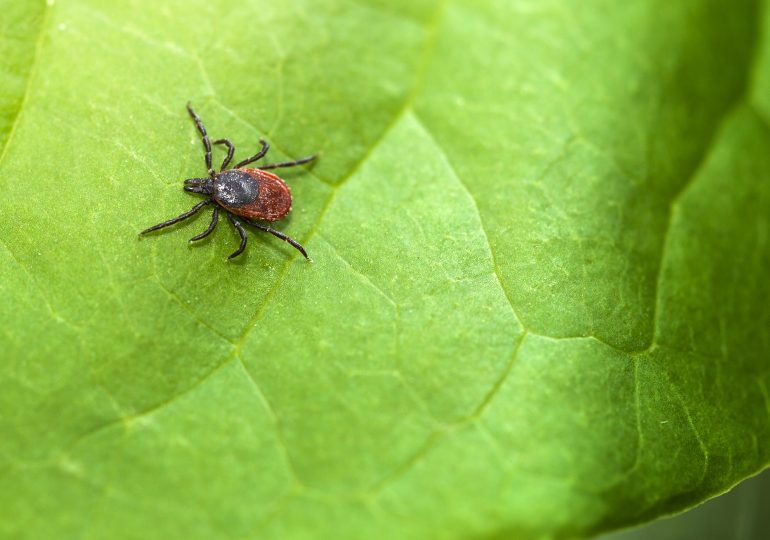If it feels like you’re suddenly seeing ticks everywhere, it’s not in your head. The U.S. tick population has exploded in recent years, largely driven by climate change, which means spotting one of these blood-sucking pests is an unfortunately routine event for people in many parts of the country.
Ticks are best known for spreading Lyme disease, an illness that can cause flu-like symptoms, body aches, fatigue, and more. By some estimates, almost half a million people in the U.S. are diagnosed with Lyme each year, with the blacklegged ticks that spread the condition particularly prevalent in the Northeast, Mid-Atlantic, and parts of the Midwest and Pacific Coast. Lyme isn’t the only tick-associated illness to know about, though. The creatures’ bites can spread a range of rarer illnesses, including Rocky Mountain spotted fever, Powassan virus disease, babesiosis, ehrlichiosis, and alpha-gal syndrome. Disease-carrying varieties are found throughout the U.S., according to the U.S. Centers for Disease Control and Prevention (CDC).
[time-brightcove not-tgx=”true”]
Despite how prevalent ticks are, many people don’t know exactly what to do if they spot one on their body. Here’s a step-by-step guide to tick prevention, removal, and follow-up care, according to experts.
How to prevent a tick bite
Prevention is always the best medicine. So it’s key to wear bug spray—products containing DEET are most effective—and dress strategically when you’ll be in tick-heavy environments, such as woodlands, fields, parks, and even some residential backyards, says Stephen Rich, executive director of the New England Center of Excellence in Vector-borne Diseases, a consortium of experts who specialize in tick- and mosquito-borne illnesses.
Wearing light-colored clothing during outdoor activities can make it easier to spot dark ticks if they get on you, Rich says. And, though it’s “not a fashion statement,” tucking your shirt into your pants, and your pants into your socks, makes it harder for ticks to get on bare skin, he adds.
Read More: Long Dismissed, Chronic Lyme Is Finally Getting Its Moment
Wearing long sleeves and pants will also minimize the amount of skin exposed to ticks, says Yetrib Hathout, director of the Binghamton University Tick-borne Disease Center in New York. Choosing breathable or sweat-wicking fabrics can make this advice more tolerable on a hot day.
You can even treat your clothes (or buy garments that are pre-treated) with permethrin, which repels ticks and insects. And if you’re really worried about ticks in your yard, you can have your land treated with tick-targeting pesticides—but, Rich notes, researchers are still studying the efficacy of that approach.
Check yourself
Hathout says it’s good practice to check your body for ticks after any outdoor activity during tick season, which generally runs from spring to fall and peaks in the summer months. Be thorough, as ticks are drawn to crevices like the armpits, back of the knees, and groin. Remember to check your scalp, too.
If you do find a tick on yourself, don’t panic. The vast majority of tick bites do not lead to disease, for several reasons.
First, not all types of ticks transmit disease to humans—and even if you’re bitten by one that can, there’s a good chance it’s not actively infected. For example, blacklegged ticks are found in the southeastern U.S. but rarely cause Lyme there, according to the CDC. Even in the Northeast, where Lyme is much more common, anywhere from roughly 25% to 50% of blacklegged ticks are actually infected, depending on the time of year and stage of their lifecycle, Rich says.
Even if you have the misfortune of being bitten by an infected tick, the CDC says it generally takes at least a day for it to transmit disease. (Rich says the average is more like 48 hours.) That gives you plenty of time to act if you find one.
All told, some estimates suggest the risk of contracting Lyme from a blacklegged tick bite is only about 1% to 3%, although that risk goes up the longer it’s in place.
Remove it
If you find a tick crawling on your body but not yet attached, dispose of it by drowning it in rubbing alcohol or flushing it down the toilet, Hathout says. Don’t crush it, he says, just in case the tick is carrying bacteria or other pathogens.
If the tick is already embedded in your skin, remove it as soon as possible. The internet is full of quirky tick-removal tactics, but Rich says there’s no need to overcomplicate matters. Just grab a pair of fine-tipped tweezers, “get close to the skin, and pull the tick off,” Rich says. “There’s no fancy work about it.”
Try to pull straight up, rather than crushing or twisting the tick, to minimize the chances of separating the tick’s body from the mouth parts embedded in your skin, Hathout says. Don’t worry too much if that happens, though, as any leftovers should eventually come out on their own.
After removing the tick, clean the bite site with soap and water or rubbing alcohol to minimize the chances of the area getting infected.
Get rid of the tick—or not
Once you’ve pulled off the tick, the CDC says it’s fine to flush it. But some experts, including Rich, recommend popping it in a plastic bag and keeping it, just in case.
Why? If you later develop symptoms consistent with Lyme or another tick-borne illness, you could have the tick tested to see if it’s carrying relevant pathogens, which could streamline your diagnosis and treatment process. “That tick basically is like woolly mammoth DNA,” Rich says. “You could go back to it at any point and have it tested,” even if it’s dead. (When Rich is bitten by a tick, he says, he brings it in for testing right away.)
The CDC, however, does not recommend that consumers use commercial tick testing services, since the results may be inaccurate or hard to interpret. Hathout says he generally agrees with that advice, unless a doctor has specifically recommended otherwise. “Sending a tick to a lab [often] is going to cause more worry—or a false negative,” he says. Even if a tick does test positive for Lyme bacteria or other pathogens, that doesn’t necessarily mean you were infected.
When to see a doctor
If you’re confident a tick was on your body for less than a day—and therefore was unlikely to transmit disease—all you need to do is remove it, clean the bite site, and move on, Hathout says.
Over the next few weeks, just keep an eye out for symptoms such as a rash (a bull’s-eye-shaped rash is a classic sign of Lyme disease), fatigue, headaches, muscle aches, joint pain, fever, or chills, says Dr. David Banach, an infectious-disease physician at UConn Health. If a health care provider determines these symptoms are linked to tick exposure, they’ll likely prescribe antibiotics to treat the infection.
Read More: We Used to Have a Lyme Disease Vaccine. Are We Ready to Bring One Back?
Things are a little trickier if you’re not sure how long the tick was attached. Sometimes, a tick is visibly engorged with blood, which suggests it was in place long enough to transmit disease. But it’s not always easy to glance at a tick and assess how long it’s been on you, Banach says—particularly since they can be as small as a poppy seed. If you think a tick may have been attached for a day or longer, consider consulting a doctor about whether you should be treated, he says.
Some studies suggest that preventatively taking an antibiotic after a tick bite reduces the risk of developing Lyme disease, and the CDC says it’s appropriate to prescribe precautionary antibiotics in certain cases. Your doctor can help decide if that tactic is right for you, depending on factors like the prevalence of disease-carrying ticks in your area, the circumstances of your bite, and your personal health profile.
Although ticks can be creepy, Hathout says they shouldn’t get in the way of enjoying the outdoors during the summer season. “I don’t think we should be very, very concerned,” he says. Ticks do pose health risks, but with some prevention and preparedness, those risks are manageable.
Leave a comment








